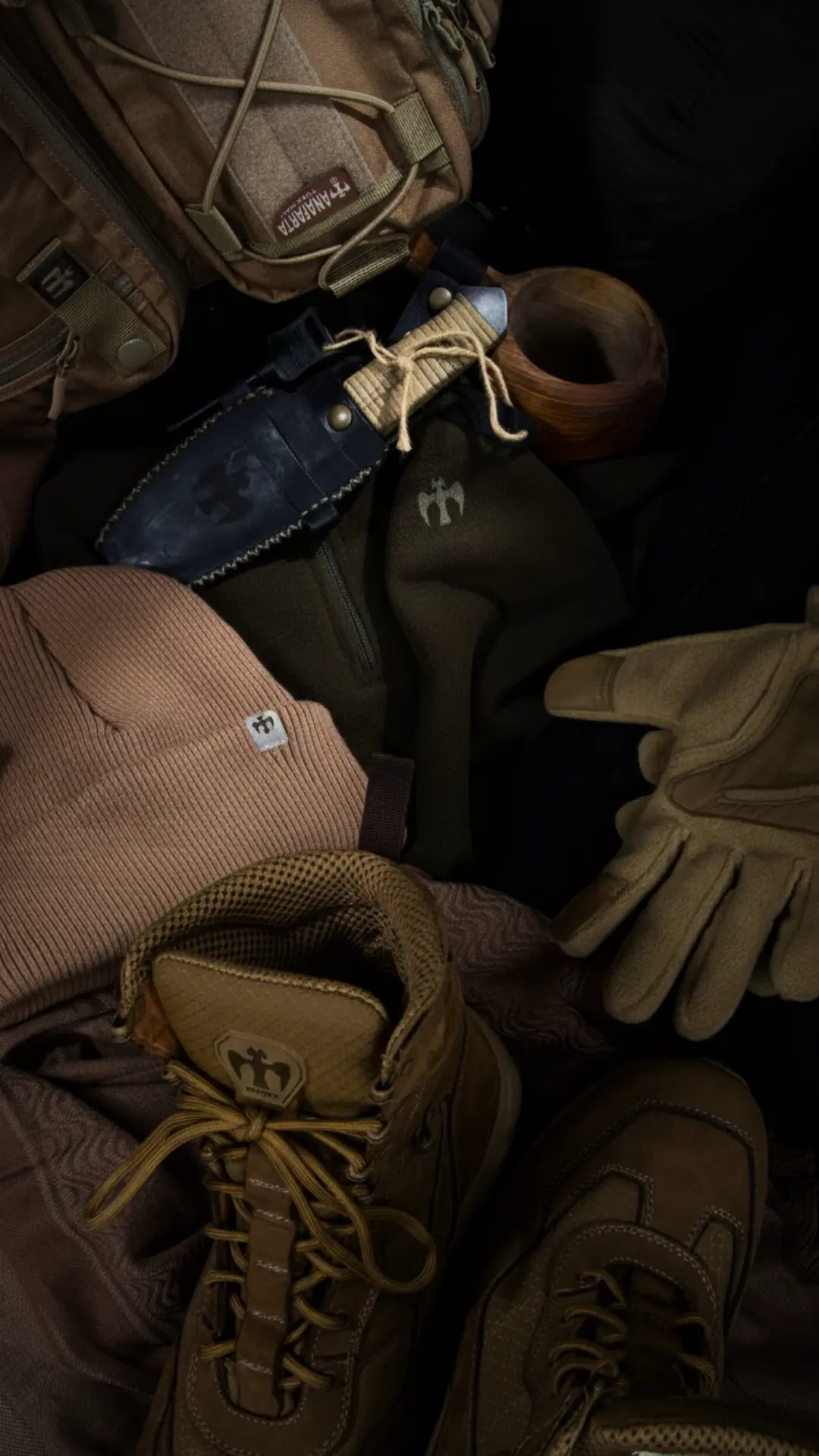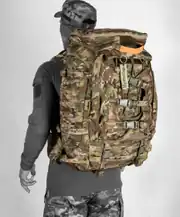How to Prepare a Tactical Backpack?
November 21, 2025 at 12:16 PMStep-by-Step Tactical Backpack Organization
Organizing a tactical backpack is the invisible part of speed and decision making in the field. The more structured the pack and the more logical the access points, the smoother the mission flow becomes. Proper organization begins before placing anything inside the pack. The first step is choosing the right tactical backpack.
1. Start by Choosing the Right Tactical Backpack
The foundation of tactical pack preparation begins with choosing the correct capacity. Mission duration, environmental conditions and total equipment load determine the ideal volume range. Choosing the wrong capacity can render even the best equipment inefficient in the field.
The table below shows the most commonly used capacity ranges and the mission types they excel in:
| Volume Range | Mission Scenario | Key Features |
| 20–35L | Urban EDC, short patrols, daily carry | Lightweight, compact structure, quick access, limited but organized internal space |
| 25–45L | Camping, hikes, 1–3 day missions | Large main compartment, MOLLE/PALS modularity, mat / sleeping bag carrying capability |
| 45–70L | Long operations, heavy-load missions | Frame support, waist belt stability, multi-compartment structure, high load bearing |
These distinctions are clearly reflected in ANAFARTA’s backpack architecture. GABARİ 16L and GÖNEN provide compact solutions for urban EDC and light missions. DAVRAZ™ 37L offers a balanced mission capacity for patrol and short operations. GABAR 4X4 and KUTAY 2+1 V2 are engineered for long, heavy-load missions, with a cross-positioned aluminum support frame and dual-layer shoulder harness that increase carrying stability.
Choosing the right capacity sets the foundation for every next step. A pack too small leaves critical equipment out; too large adds unnecessary weight.
2. Define the Mission Objective
The answer to the question “How to prepare a tactical backpack?” depends entirely on clarifying the mission purpose. Weight, equipment categories and layout logic all depend on this decision.
As mission duration increases, food, water, spare clothing and shelter items become more essential. Cold climates prioritize insulation and shelter, while hot climates require water capacity and ventilated back panels. Models like GABAR 4X4 and SADAK-3, with 3D mesh back panels, improve sweat control during long walks.
High-risk missions prioritize radios, spare batteries and medical gear. The multi-compartment structure of KUTAY 2+1 V2 makes category-based arrangement much easier.
When the mission objective is clear, the pack becomes streamlined and mission-focused.
3. Categorize Equipment Before Packing
Laying out all equipment on the ground and grouping it into categories saves significant time in the field. This step establishes the access logic in advance and reduces search time during critical moments.
Main categories include:
- Water and food
- First aid and emergency response
- Fire and light
- Cutting tools and tool kits
- Shelter and insulation
- Navigation and communication
- Spare clothing
Backpacks like GABARİ 16L, with hydration bladder-compatible inner sleeves, keep water and food modules stable. DAVRAZ™ 37L, with its internal organization panel, allows small electronics, notebooks, mini-medkits and multitools to be separated into category-based pockets. Large MOLLE/PALS surfaces on GABAR 4X4, KUTAY 2+1 V2 and SADAK-3 allow medkits, admin pouches and radio holders to be positioned mission-specifically.
When categorization is done, the tactical pack becomes far more controlled and repeatable.

4. Organize According to Center of Gravity
The correct placement of weight inside the pack directly affects mobility. Incorrect distribution creates unnecessary load on the waist and shoulders even during short walks.
- Heaviest equipment should be placed closest to the back panel and near shoulder height. This includes ammunition, water bladders, metal tool kits or dense medical modules. The aluminum support frame in GABAR 4X4 and KUTAY 2+1 V2 keeps this load aligned with the body.
- Medium-weight items should sit in the mid layer of the main compartment. Clothing, extra food and shelter modules fit this category. The internal structure of DAVRAZ™ 37L supports this balanced placement.
- Light but bulky items, such as sleeping bags, tarps or rain shells, should be carried in bottom straps or top expansion areas.
This system keeps the tactical backpack balanced and compact.
5. Water and Food Organization
Water heavily affects the pack’s center of gravity. If using a hydration bladder, it should be placed vertically against the back panel for maximum stability. GABARİ 16L supports this with a dedicated bladder sleeve, while GABAR 4X4 and KUTAY 2+1 V2 allow both bladder and canteen setups.
Food should be compact and high in energy: energy bars, nuts, freeze dried meals, compact carb supplements. This module should sit mid-layer, where it doesn’t disrupt balance. DAVRAZ™ 37L offers a well-balanced arrangement for this purpose.
As mission duration and intensity rise, water and food modules must be scaled accordingly.
6. Pack the Emergency Kit Separately
Your emergency kit should behave as a stand-alone module inside the pack. It must remain in the fastest-accessible location and stay completely separate from other equipment.
Core items include:
- Compact first aid kit
- Basic bleeding control supplies
- Flashlight or mini light
- Fire starting tools
- Small knife or multitool
- Spare batteries and emergency whistle
The best method is packing this kit in a MOLLE/PALS compatible admin pouch. The front pool system of GABAR 4X4, the quick-access front pocket of DAVRAZ™ 37L or the underside of the top compartment in KUTAY 2+1 V2 all serve as ideal positions.
This allows emergency gear to be accessed instantly without opening the entire pack.
How Should the Interior of a Tactical Backpack Be Organized?
Interior organization determines how fast you can decide and act in the field. The core principle is a hierarchy based on access frequency:
- Top pockets for frequently used small items: flashlight, gloves, glasses, mini-medkit, multitool, notebook, spare batteries. DAVRAZ™ 37L’s padded eyewear pocket is an excellent example.
- Front panel for quick access critical tools: fire-starting kit, cutting tools, basic first aid, mission cards. The front pool system of GABAR 4X4 is designed for this.
- Main compartment for bulky but less frequently accessed equipment: spare clothes, shelter tools, extra food modules, filtration kits. The expandable top section of GABAR 4X4 and KUTAY 2+1 V2 makes this practical.
- MOLLE/PALS modularity allows mission-based restructuring. Models such as SADAK-3, KUTAY 2+1 V2 and GABAR 4X4 offer wide MOLLE surfaces for medkits, admin pouches, magazine pouches and radio holders.
Essential Gear for Every Tactical Backpack
Some equipment forms a common core across most missions:
| Category | Example Items |
| Water & Food | Hydration bladder or canteen, energy bars, nuts, electrolytes |
| First Aid | Basic medkit, bandages, sterile gauze, gloves, tourniquet, simple pain reliever |
| Fire & Light | Lighter, magnesium rod, waterproof matches, flashlight, spare batteries |
| Cutting Tools | Fixed blade, folding knife, multitool, mini saw |
| Shelter / Insulation | Thermal blanket, rain shell, lightweight tarp |
| Navigation | Map, compass, GPS, pen, notebook |
| Communication | Radio, spare battery, waterproof phone pouch |
| Spare Clothing | Socks, underwear, lightweight fleece or T-shirt |
| ID / Documents | ID, mission card, laminated instructions |
| Various | Paracord, zip ties, marking tape, mini sewing kit, carabiner |
Smaller packs like GABARİ 16L and GÖNEN require a simplified core set. DAVRAZ™ 37L can carry it at near full capacity. Large operation packs like GABAR 4X4 and KUTAY 2+1 V2 can carry extended modules such as advanced medical, shelter and additional rations.
Frequently Asked Questions
What items should go into a tactical backpack?
Only mission-essential items. Core categories include water and food, first aid, fire and light, cutting tools, navigation, communication and spare clothing. As mission duration increases, shelter and extended energy modules are added.
How should the interior be organized?
Organization follows access hierarchy: frequently used items in top and front pockets, medium-weight gear in the main compartment, and lightweight, bulky items in external loops. MOLLE/PALS modularity enhances both order and access speed.
What capacity should a tactical backpack be?
- 20–35L for EDC and short patrols
- 25–45L for 1–3 day missions
- 45–70L for long operations or heavy load-out missions
Volume must match mission duration, climate and critical equipment load.
How should weight distribution be done?
Place the heaviest items close to the back and near shoulder height. Mid-weight items go in the center of the main compartment. Light, bulky items stay in the lower or outer sections. This reduces sway, improves balance and significantly decreases fatigue.





